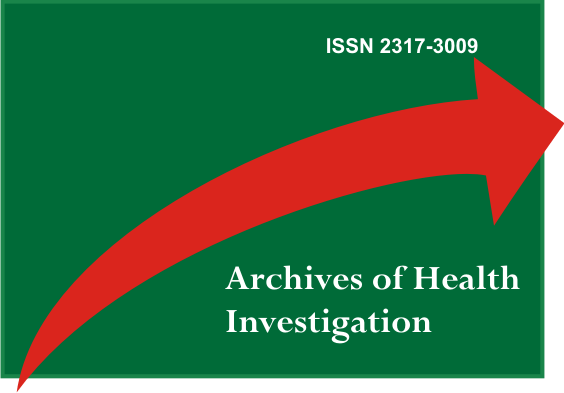Incorporação de clorexidina à superfície da liga Ti7,5Mo após modificação de superfície com crescimento de nanotubos de TiO2 associado a eletrofiação
DOI:
https://doi.org/10.21270/archi.v5i6.1792Resumo
Ligas de titânio são amplamente utilizadas na reparação de tecido ósseo devido suas excelentes propriedades de volume. Neste estudo foram analisado o potencial bactericida de tratamentos de superfície na liga Ti7,5Mo. As amostras foram anodizadas em NH4F/H2O/glicerol para crescimento de nanotubos de TiO2, posteriormente foram cobertas com uma manta de PCL eletrofiado e realizado a incorporação de clorexidina por dois métodos, imersão e gotejamento. A superfície foi analisada por microscopia eletrônica de varredura e medidas de ângulo de contato. O efeito bactericida foi analisado por meio da cultura de C. albicans e S. aureus. A incorporação por imersão apresentou resultados mais satisfatórios.Descritores: Materiais Biocompativeis; Titânio; Ligas; Nanotubos; Propriedades de Superfície.
Downloads
Referências
Alves Rezende MC, Alves AP, Codaro EM, Dutra CAM. Effect of commercial mouthwashes on the corrosion resistance of Ti-10Mo experimental alloy. J Mater Sci Mater Med. 2007; 18(1):149-54.
Chelariu R, Bolat G, Izquierdo J, Mareci D, Gordin D M, Gloriant T, Souto RM. Metastable beta Ti-Nb-Mo alloys with improved corrosion resistance in saline solution. Electrochim Acta. 2014; 137:280-9.
Kubota S, Johkura K, Asanuma K, Okouchi Y, Ogiwara N, Sasaki K, Kasuga T. Titanium oxide nanotubes for bone regeneration. J Mater Sci: Mater Med. 2004; 15(9): 1031-5.
Cai Q, Paulose M, Varghese OK, Grimes CA. The effect of electrolyte composition on the fabrication of self-organized titanium oxide nanotube arrays by anodic oxidation. J Mater Res. 2005;20(1):230-6.
Macák JM, Tsuchiya H, Schmuki P. High‐aspect‐ratio TiO2 nanotubes by anodization of titanium. Angew Chem Int Engl. 2005;44(14): 2100-2.
Macak JM, Tsuchiya H, Taveira L, Ghicov A, Schmuki P. Self-organized nanotubular oxide layers on Ti-6Al-7Nb and Ti-6Al-4V formed by anodization in NH4F solutions. J Biomed Mater Res A. 2005; 75(4):928-33.
Song YY, Schmidt-Stein F, Bauer S, Schmuki P. Amphiphilic TiO2 nanotube arrays: an actively controllable drug delivery system. J Am Chem Soc. 2009; 131(12): 4230-2.
Eaninwene G 2nd, Yao C, Webster TJ. Enhanced osteoblast adhesion to drug-coated anodized nanotubular titanium surfaces. Int J Nanomedicine. 2008; 3(2):257-64.
Bayram C, Demirbilek M, Yalcın E, Bozkurt M, Doğan M, Denkbaş EB. Osteoblast response on co-modified titanium surfaces via anodization and electrospinning. Appl Surf Sci. 2014; 288: 143-8.
Kim SH, Nam YS, Lee TS, Park WH. Silk fibroin nanofiber. Electrospinning, properties, and structure. Polymer J. 2003; 35(2):185-90.
Maheshwari S, Chang HC. Assembly of Multi‐Stranded Nanofiber Threads through AC Electrospinning. Adv Mater. 2009; 21(3): 349-354.
Bhardwaj N, Kundu SC. Electrospinning: a fascinating fiber fabrication technique. Biotechnol Adv. 2010; 28(3): 325-47.
Leung V, Ko F. Biomedical applications of nanofibers. Polym Adv Technol. 2011; 22(3): 350-5.
Kolambkar YM, Peister A, Ekaputra AK, Hutmacher DW, Guldberg RE. Colonization and osteogenic differentiation of different stem cell sources on electrospun nanofiber meshes. Tissue Eng Part A. 2010; 16(10): 3219-30.
Son YJ, Kim WJ, Yoo HS. Therapeutic applications of electrospun nanofibers for drug delivery systems. Arch Pharm Res. 2014; 37(1):69-78.
Escada ALA, Nakazato R, Claro APR. Growth of TiO2 Nanotubes by Anodization of Ti–7.5Mo in NH4F Solutions. Nanosci Nanotech Let. 2013; 5(4):510-2.
Wada CM, Rangel ALR, de Souza MA, Almeida RDS, D’Ávila MA, Alves Claro APR, Alves Rezende MCR. Surface Modification of Ti-30Ta Alloy by Electrospun PCL Deposition. Mater Sci Forum. 2016; 869: 930-4.
Pereira CA, Romeiro RL, Costa ACBP, Machado AKS, Junqueira JC, Jorge AOC. Susceptibility of Candida albicans, Staphylococcus aureus, and Streptococcus mutans biofilms to photodynamic inactivation: an in vitro study. Laser Med Sci. 2011; 26(3):341-8.
Regonini D, Bowen CR, Jaroenworaluck A, Stevens R. A review of growth mechanism, structure and crystallinity of anodized TiO 2 nanotubes. Mater Sci Eng: R: Reports. 2013; 74(12): 377-406.
Campoccia D, Montanaro L, Arciola CR. The significance of infection related to orthopedic devices and issues of antibiotic resistance. Biomaterials. 2006; 27(11):2331-9.
Tote K, Horemans T, Berghe DV, Maes L and Cos P. Inhibitory effect of biocides on the viable masses and matrices of Staphylococcus aureus and Pseudomonas aeruginosa biofilms. Appl Environ Microbiol. 2010; 76(10): 3135-42.
Lamfon H, Porter SR, McCullough M, Pratten J. Susceptibility of Candida albicans biofilms grown in a constant depth film fermentor to chlorhexidine, fluconazole and miconazole: a longitudinal study. J Antimicrob Chemother. 2004; 53(2):383-5.


